Niddodi Power Project: The threat is looming large
Niddodi Power Project: The threat is looming large
Mangalore Today News Network
 Mangalore, July 1, 2013: An unknown fear is clearly visible in the eyes of each and every resident of a tiny hamlet in Kallamundkur Gram Panchayat in Moodbidri. This fear has gifted them worried days and sleepless nights. The tranquility of the picturesque village of Niddodi nestled in idyllic surroundings with verdant greenery has been disturbed ever since news broke that the government was planning a 4000 mw ultra mega thermal power plant some time in February this year.
Mangalore, July 1, 2013: An unknown fear is clearly visible in the eyes of each and every resident of a tiny hamlet in Kallamundkur Gram Panchayat in Moodbidri. This fear has gifted them worried days and sleepless nights. The tranquility of the picturesque village of Niddodi nestled in idyllic surroundings with verdant greenery has been disturbed ever since news broke that the government was planning a 4000 mw ultra mega thermal power plant some time in February this year.
“No, there is no way we will let our land for this project and sacrifice the greenery, We will not allow the company at any cost,” when a 70 year old farmer of this village with agriculture as its predominant occupation says so, he echoes the sentiments of a vast majority of populace of Niddodi. “How can we ? This is our land, it gives us our daily bread and we are emotionally attached to it,” he further adds with a certain degree of firmness. His anger is palpable. Amid the serene lush greenery at Niddodi, a village located between Kateel and Moodbidri, with a population of around 2,500, residents have been constantly raising voice against the proposed project. Out of the 2600 odd acres of land at Niddodi only 70 acres is barren, villagers point out.
The first mention of the project came during the Budget speech of the then Chief Minister Jagadish Shettar when he formally announced the 4,000 MW project at the village. Later, came reports about Shettar urging the Centre to expedite the project. In a letter to Union Minister of State for Power Jyothiraditya Scindia, the then chief minister had informed that a team of officials from Power Corporation of Karnataka Limited, Karnataka Udyog Mitra and Karnataka Industrial Area Development Board?(KIADB) had carried out a site inspection in and around the coastal areas of Karnataka and had identified Niddodi village, located close to Mangalore, as a suitable location.
Ever since then, the proposed 4000 mw ultra-mega thermal power project has been haunting Niddodi like a ghost and there have been numerous protests by villagers clearly signifying that they are dead against the project and they will stand like a rock to oppose the project come what may.
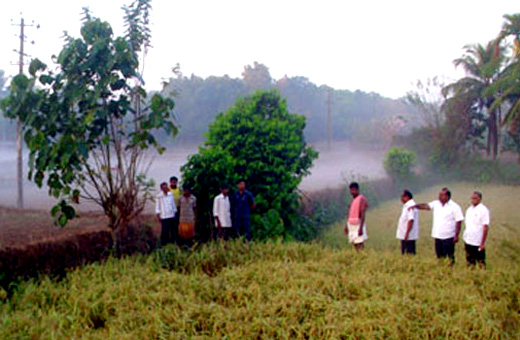
They have every reason to oppose this project when the tell tale picture of Ellur near Padubidri and other surrounding villages which continue to battle the air and water pollution unleashed by the 1200 mw UPCL thermal power plant, is before them.
Numerous protests, repeated appeals to government, have fallen on deaf ears and the plant continues to pollute the atmosphere and the environment of the area, causing irreparable damage and wrecking lives. When this classic example is before them at close quarters, there is no way of allowing the Niddodi project, villagers are clear when they say so.
For Niddodi, the Matru Bhoomi Samrakshana Samithi is spearheading the agitation against the project and is leaving no stone unturned in mustering support for its cause. The Samithi which has the track record of successfully waging a war against the Suvarna Corridor Project during the chief ministership of Yeddyurappa, has also submitted appeals to various authorities and is ceaselessly striving to persuade the government to drop the project through its apolitical means of agitation.
There is a fear that given the magnitude of the project and given the environmental impact of the 1200 mw UPCL thermal plant at Ellur, it would be not just Niddodi but even several nearby villages such as Tenkamijaru, Badaga Mijaru, Mucchur, Puttige, Kallamundkur, Kateel, Kinnigoli and Yedapadav which are likely to be affected by the by dust, smoke and also contamination of River Nandini.
That the proposed Niddodi power plant would be four times larger in capacity than the UPCL is itself one major cause of worry. “ Certainly, such a project would do much greater harm, and we will lose our livelihood,” says a farmer who grows cashew and arecanut in his 2.8 acre land.
Some of the reasons that might have prompted the authorities to consider Niddodi an ideal location for the proposed project may be that the village is just about one and a half hours of drive from the port of Mangalore, thereby making transport of coal easy for the 4,000 MW plant. Another aspect is that transmission of power may not be a problem as a power line already runs from Udupi to this place. Another main reason is the shortage of power which the state has been facing over the years. But at what cost?, question people of Niddodi.
They have already have made their intentions clear when a team of officials from the Central Electricity Authority (CEA) and Power Finance Corporation Consulting Limited (PFCCL) accompanied by officials from the Directorate of Archaeology visited Niddodi, in all probability for a survey. The team had to face the ire of the villagers, when it was gheraoed by them.
The villagers blocked the road when the team led by the Central Electrical Authority Officer MS Puri was returning after inspecting the site. The explanation given by the authorities then was that the Central Team had not arrived for a survey of the land, but to study the distance between Niddodi, Western Ghats Port and the rail route.
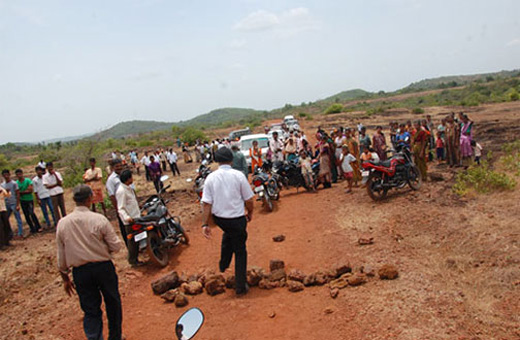
MS Puri, the team head said they had visited to review the geographical condition and that all measures would be taken after taking villagers into confidence.But, it is still not clear as to how far the authorities have presented facts before the villagers.
Whither Carrying Capacity?
The big question is can the ecologically sensitive district cope with such a mega project? Already, many reports on sustainable development of coastal Karnataka have given a clear recommendation to conduct the ‘Carrying Capacity’ study of the whole region, which includes the impact of all the existing and planned projects for the region, before finalizing the site for each such project.
But, so far no such study has been done. In this context, the Nandikur Jana Jagrithi Samithi, which has been in the lead against the fight against UPCL and has been backing the Niddodi stir, alleges that the state government in 1999 had secretly withdrawn the notification for conducting the carrying capacity study specifically to provide free passage for setting up of UPCL at Udupi, which has adversely affected agriculture in the region.
Though there is not much of an information regarding the proposed project at Niddodi which is expected to be implemented by the NTPC,various organizations which have been fighting against the UPCL thermal power plant, too have pledged support for the cause.
Opposition to the proposed ultra mega project is brewing. The Jana Jagruthi Samithi, Nandikur, which has been waging a war against the UPCL thermal power plant in Ellur near Padubidri is skeptical regarding the proposed power project at Niddodi. "In the event of this project coming up at Niddodi, the total burning of coal in the coast will be well over 55,000 tonnes a day, with more than 10,000 tonnes of ash generated on a daily basis along with 30 kg of lethal mercury and various other carcinogenic pollutants," the Samithi states. The thermal power plant of Udupi Power Corporation Ltd at Yellur is already burning about 12,000 tonnes of coal and generated ash and other waste close to 2,000 tonnes a day, the Samithi says thus making a strong case for the dropping of the proposal.
There have been protests, public meetings and road block agitations against the project, under the aegis of the Mathra Bhoomi Samrakshana Samithi. People want their voices to be heard by those at the helm of affairs.
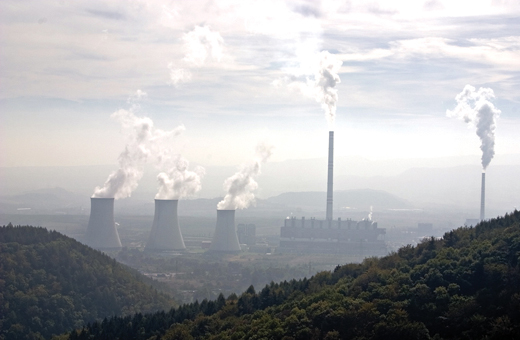
Kiran Manjanbailu, Convenor of the Matru Bhoomi Horata Samithi is categorical when he says that Niddodi was not at all an ideal place for a mega thermal power project. He fears that hundreds of families relying on agriculture would be rendered displaced if the project was initiated.
Joachim Koreya, Kallamundkur Gram Panchayat President, on the other hand states that the villagers will fight till the finish against the proposed project which would prove a death knell to agriculture in the village.
Pejawar seer Sri Vishwesha Theertha Swamiji too voices his dissent to the proposal of having a 4000 mw project at Niddodi. “It is a totally unacceptable project and is unsuitable for the coastal region,” the seer observes. Besides environmental problems, it would lead to the destruction of fertile agricultural land and affect the livelihood of a large number of people,” says the seer.
Bhasker Devasya, entrepreneur has this to say ” We have seen the hazards posed by UPCL thermal plant right before our eyes. The proposed project is expected to render thousands of farmers as well as agricultural labourers destitutes. There is no question of agreeing for this project.”
Premanand Kalmady, environmentalist of Udupi, observes that the government seems to be very much interested in setting up a mega thermal plant in Niddodi at a time when the UPCL plant at Padubidri has given untold problems to the locals. Cautioning that Niddodi may be rendered barren due to the project, he strongly favours a debate on the pros and cons of the project. The authorities should have conducted a public hearing before announcing the project, he feels.
Some even suspect the hands of a land mafia behind the 4000 mw project proposal, while others fear the proposed Moodbidri taluk may lose its existence if the project is initiated.
Says Shanker Sharma, the well-known power analyst –“ Most proposed thermal plants in the nation have the potential to become huge liability without the processes of due diligence in realistic demand projection, project design, analysis of costs & benefits to the society, approvals etc. Moreover, they also need large tracts of land, fresh water and coal. The social, economic and environmental implications of such projects too should be areas of major concern.”
Polluting industries, and large scale diversion of coastal land to industrial activities are likely to have serious impacts on coastal environment including that of the coastal water. Polluting industries such as coal power plants can devastate the vegetation in WGs. Hence careful management of the ecology of the coast is critical,observes Sharma.
Coal, as a fossil fuel, is fast running out and is encountering a lot of issues such as the ever tightening environmental regulations, the escalating price and decreasing reliability of supply. The popular oppositions around the world to the coal mining and coal power plants are escalating because of the recognition of social, economic, environmental and health issues associated with the mining, transportation and burning of coal. Coal’s global warming potential is acknowledged as huge, because of which there are persistent calls for early retirement of coal power plants. Still, going in for more power plants may prove too costly. A modest understanding of the ground realities of coal industry around the world and constraints within India can lead us to predict that this situation of unreliable supply and unpredictable price of coal will continue to haunt the power companies in India for many years to come, if at all it can be resolved satisfactorily ever. Already, the 1200 mw UPCL plant at Ellur had faced problems due to non-availability of coal on time on many an occasion. Still, going in for a power project as large as 4000 mw capacity is a risky affair.
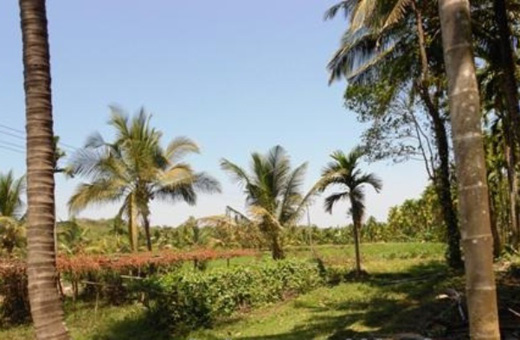
Niddodi continues to boil. Though the present Congress government has not yet made its intentions clear on this proposed project, apprehensions continue. Environment and development have remained and continue to remain two conflicting issues under debate in the coastal region since the past several years. Electrical power sector, because of its essential nature to the modern lifestyle, has become a contentious part of our economy due to multifarious crises facing it.A credible power policy, keeping in view the legitimate demand in the next 25-30 years and keeping its long term sustainability in focus, has become critically important to ensure all-round development of different sections of our society, and to discharge our obligations to the future.
The ecologically sensitive region had to always battle it out when it came to mega projects which were not only feared to cause environmental problems, but have also created problems in reality, problems that have caused irreparable damage to environment. Do we need one more such gigantic project in an ecologically fragile region?
A long battle
The undivided DK district has had a long history of battling against power projects. A Karnataka Power Corporation project was found unfeasible in the year 1987; in 1992, NPCL had to suspend work on its project in Udupi after failing to obtain sanctions from the Union Government’s Cabinet Committee on Economic Affairs. In 1999, US based Cogentrix company had to drop its 1000 mw thermal power project in Udupi following stiff protests and court litigations. However, it was only the Udupi Power Corporation Ltd’s thermal power plant (formerly Nagarjuna) which could make it finally in November, 2010, despite stiff resistance and since then causing irreparable damage to environment and human life. Now, a 4000 mw project is proposed at Niddodi much against the wishes of the people.
Fighting for “MathrU Bhoomi”
For the people of Niddodi, the Mathru Bhoomi Samrakshana Samithi has been a light at the end of the tunnel. The Samithi which has been successful in forcing the government to drop the Suvarna Corridor Project in 2011, has now plunged head on to fight the proposed 4000 mw Niddodi thermal power plant tooth and nail. It is already at work and has submitted several memoranda to the authorities concerned and those at the helm of affairs seeking to drop the project and also citing justifiable reasons for the same.
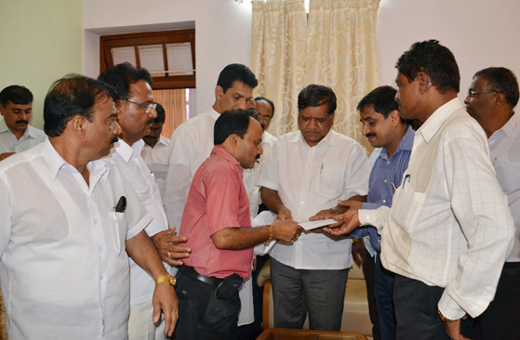
The Samithi and its cause are duly backed by various organizations like Raitha Sangha, Nagarika Seva Trust, Guruvayanakere, Kudubi Sangha, Brahmana Sangha, Billawa Sangha and Nandikur Jana Jagrithi Samithi, which have further added strength to the movement. Most importantly, people of Niddodi are united against the project. This unity is expected to be the rallying force that may yield desirable results in the near future.
Giant requirements
According to one estimate, the 4000 mw ultra-mega thermal plant proposed at Niddodi may need at least 4000 acres of land, when compared to the 2000 acres of land used for the 1200 MW capacity UPCL project. With 85 per cent of land in Nddodi being cultivated, naturally the project has brought fears among farmer families. It is not just the farmers, but also agricultural labourers and their families which would be rendered destitutes. People even fear that the underground water resources of the village too may be hit hard due to the project.The proposed project would also require abundant quantity of water to generate 4000 mw of power, particularly when just a single mw of power generation needed 800 litres of water. A coal power project of this size is expected to need about 5 TMC of fresh water annually. Since this much of fresh water cannot be diverted from the rivers of the region, desalinated water may have to be sourced from the Arabian sea, which will be associated with its own environmental problems such as pollutants from the desalination process, and the huge amount of energy needed for the process itself, points out power analyst Shanker Sharma. The failure of the KIADB to furnish adequate information to the villagers, has also come under fire. An open letter to the Chairman, NTPC, New Delhi
An open letter to the Chairman, NTPC, New Delhi
From Shankar Sharma, Power Policy Analyst, Thirthahally, Karnataka and others from coastal Karnataka.
We, on behalf of a large number of concerned people in coastal Karnataka, would like to highlight the inappropriateness of the proposed site for a coal based UMPP in coastal Karnataka.
1. While considering any coastal location in Karnataka for such a heavy industry, with potential for huge environmental impacts, the sensitivity of Karnatakas’s coastal areas should be kept in objective view. Many reports on sustainable development of coastal Karnataka have unequivocally explained the fragile nature of the coast, and have cautioned extreme care in the type of developmental activities there. Five such reports are: (1) “Industrial and Economic perspective of Dakshina Kannada” by Karnataka Centre for Infrastructure Planning; (2) A report by DANIDA – Management of Sustainable Development - 1993-95, (3) NEERI Report – 1996, (4) Carrying capacity for industrialisation of a region – 1998, (5) Karnataka’s Environmental Status and Action Plan -2003. All these reports have said one thing in common: that the local conditions of a region like Dakshina Kannada district, which are ecologically very sensitive, should be a major consideration while selecting the site for any large scale project like coal fired power station.
2. Another clear recommendation has been to conduct the ‘Carrying Capacity’ study of the whole region, which includes the impact of all the existing and planned projects for the region, before finalizing the site for each such project. The government and the society should take seriously the recommendations by such expert committees, which have been set up by the governments. Polluting industries, and large scale diversion of coastal land to industrial activities are likely to have serious impacts on coastal environment including that of the coastal water. Polluting industries such as coal power plants can devastate the vegetation in WGs. Hence careful management of the ecology of the coast is critical in managing the Global Warming impacts in the state.
3. Coastal Karnataka is a narrow strip of land with porous soil between Arabian Sea and tall Western Ghats. Huge pollutants released into the air by a UMPP cannot get dispersed widely because of these reasons, and will destroy the thick vegetation in the area, including that of highly sensitive Western Ghats.
4. A coal power project of this size is expected to need about 5 TMC of fresh water annually. Since this much of fresh water cannot be diverted from the rivers of the region, desalinated water may have to be sources from the Arabian sea, which will be associated with its own environmental problems such as pollutants from the desalination process, and the huge amount of energy needed for the process itself.
5. Already a coal based power plant (of capacity of about 1,200 MW) is operating in the foothills of the Western Ghats in the neighboring district of Udupi, and has been associated with huge problems for the locals, who have been agitating against it for years.
6. If we also take into account the cancellation of three coal power project proposals near Tadadi, Chamalapura and Hanukon in Karnataka in recent years due to popular opposition, and the fact that a massive opposition is ongoing against another coal power project near Gulbarga it becomes evident that coal power projects are not welcomed by the people of the state.
7. Since the power generated by the proposed UMPP will not be needed in the coastal area, the same has to be transported over the sensitive Western Ghats to the load centre in Karnataka, Tamil Nadu and Andhra Pradesh. This will mean a large number of High Voltage transmission lines passing through the thick forests of UN Heritage sites, necessitating felling of a large number of trees in one of the hottest of the bio-diversity hotspots.
8. While burning of large quantities of coal in such an UMPP (Millions of tones every year) will release huge quantities of Green House Gases (GHGs) and other pollutants, cutting down of forests for High Voltage transmission lines will reduce the carbon sequestration ability of these forests. The result is a massive net contribution to the Global Warming effect.
Taking all these issues into objective consideration it seems credible that the proposed project will face a lot many hurdles. It is also apparent that an objective analysis of all the direct and indirect costs and benefits of the proposed project, including social, environmental and health costs, is likely to reveal that the total costs to the society will be much higher than the benefits.
The public would expect that a national level entity like NTPC to exhibit much higher level of social /corporate responsibility, and consider deploying its expertise and resources to effectively function also as an Energy Service Company, and provide this much of savings/ virtual additional power to Karnataka, instead of burdening the state with so many social and environmental costs through the proposed UMPP.
Keeping all these issues in objective consideration, the people of the state would like to know the techno-economic rationality of the present project proposal from the welfare perspective of Karnataka state, and NTPC’s obligations towards mitigating the Global Warming phenomenon. We will appreciate early clarifications in this regard.
- Rethinking Drug Seizure Coverage: A Call for Health-Centred Narratives
- Substance abuse - A pressing concern among medical students
- China is winning the trade war without fighting
- Poll promises can become political nightmares
- While India sticks to death by hanging other execution methods vary across the world
- Spiking of drinks, a grave threat for students’ security
- Burden of drugs and substance use among university students in India
- Mangalore medic’s miracle in Bombay 1957
- Needed a national protocol for treatment of substance use disorders
- The Lingering Menace of Drug Abuse Among the Indian Youth—It’s Time for Action
- Need For ‘Students, Alcohol and Drugs’ survey
- New Synthetic Drugs Trapping Youth
- Mood Modifying Chips - Future of Drug Use
- Kashmir Bhavan in Bengaluru: A must visit place
- "MAI and I" Book of Angelic Emotions
- Draupadi Murmu - The New ’President of India’
- Anthony Ashram in the city grows a classic museum
- First College of Fisheries in India - A Golden Jubilarian
- Flushing Meadows - A Vintage Mansion
- The Colonel�s Bequest
- A Mangalorean PM and his RBI Governor Brother: The Extraordinary story of the Benegal Brothers
- There is no higher religion than Truth: Theosophical Society
- L�affaire - Ashu & Yiju of Mangalore
- Mangalore in Kowloon
- 1568 to 2018 AD: 450 years of Christianity in Mangaluru
- Vice President elect Naidu moves on from nadir to zenith, the phenomenal journey
- Embracing the Outdoors: How Heated Jackets Are Revolutionizing Cold Weather Activities
- Efficient and Sustainable Packaging Solutions with FIBCs
- The Hybrid Kilt Revolution | Where Tradition Gets Trendy
- Affordable Elegance | Embrace Style on a Budget with Cheap Kilts
- Unleashing Style and Functionality | Exploring Tactical Kilts
- Mangalore’s Heroic Lady marks 105th Birthday
- Santa the Christmas spirit
- Geriatric care: Mangalore strikes a fine balance
- The Don Who Made Two Empires to Clash
- CHITRAPUR SARASWATS - A Great Kanara Community
- Our new President Ram Nath Kovind’s significant journey to Rashtrapathi Bhavan
- Marriages made in heaven, big fat weddings made in India
- Eid insight - The giver of glad tidings
| Comments on this Article | |
| Gananath B Shetty, Nandikur/Mumbai | Mon, July-1-2013, 11:56 |
| We do not understand why govt. wants coal based thermal plants in our ecologically sensitive area ? Coal plants are not sustainable in our twin districts especially due to the unique geographical, meteorological, ecological, environment conditions. Today we are experiencing in Nandikur how badly the surroundings affected due to the large scale pollution by UPCL (Nagarjuna), more than 4000 acres of agricultural land has been destroyed, well water in nearby villages is contaminated, respiratory ailments like astama, skin infection, bronchitis breathing problem has become common now | |
- CITY INFORMATION
- TRAVEL
- TOURIST INFORMATION
- HEALTH CARE
- MISCELLANEOUS




 Write Comment
Write Comment E-Mail To a Friend
E-Mail To a Friend Facebook
Facebook Twitter
Twitter  Print
Print 

